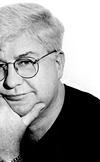 Brian Keith Reid,
PhD
Brian Keith Reid,
PhD
by a Society of Archbishop Justus colleague
BRIAN REID'S WORK IN COMPUTER SCIENCE began as a student at the University of Maryland in the late 1960s. After his bachelor's degree, he continued for a year or so with the university, in simulation and numerical analysis for Apollo 17. He then joined a company working in the area of realtime airline scheduling and reservation systems.
Returning in the mid-1970s to university, Reid became a doctoral student at Carnegie-Mellon University in Pittsburgh, Pennsylvania. At CMU, Reid was a part of the core team that defined Internet email standards (1976). Reid sees his best contribution to that team as inventing the notion of 'virtual community' that led to global email groups.
His dissertation (1978-1980) focussed on the concept of creating documents that could be formatted independently of printers; for this he developed a page-description language he called Scribe, which contained in it the seeds of what we know now as HTML.
After earning his PhD, Reid was invited to join the faculty at Stanford University, where he was a member of the electrical engineering and then the computer sciences departments. At Stanford, Reid created a successful interdepartmental network using Ethernet (1981). 'We coined the name SUN--Stanford University Network--for this; the name was later borrowed by a company you may have heard of'.
In 1983, Reid 'discovered the interaction of technology and politics with respect to network empire and administration, uncovering the need for a device that would allow administrators on both sides of the boundary to feel safe and in control'. Convincing the medical center networks group to build this prototype, it became 'more or less exactly as we specified it, the first Cisco router'. During this time Reid and several colleagues founded a company that later became Adobe Systems.
Leaving academia in 1987, Reid joined the research arm of Digital Equipment Corporation, eventually becoming director of the Network Systems Laboratory. Amongst other achievements, Reid and his group created the first Internet firewall in 1987 and built the first high-powered Internet search engine, AltaVista, in 1995. (An overview of some of his lab's work was featured in a New York Times article in December 1997.)
Independently he developed a distributed data-collection scheme to measure USENET flow and readership, publishing monthly results. He ran this until July 1995, producing the only worldwide aggregate readership data that exists for that era. ('One of the reasons I stopped was that the Web made the numbers plummet. I decided that whatever Usenet did that was useful was being supplanted by the Web.' --Reid in a New York Times article, June 1999)
Reid designed Digital's bid on the replacement of the NASDAQ stock exchange network in 1992. 'Digital won the bid and I spent the next two years engineering this network. NASDAQ wanted to design for N transactions per day; I wanted to design for 1000N transactions per day. I prevailed, sort of: we went for 500N (the exact number is a trade secret). The new network has exceeded NASDAQ's originally planned capacity (but not mine) about a dozen times since it went online'.
Reid, with his colleagues, launched http://www.digital.com in October 1993, making Digital the first Fortune 1000 company with a web site. In 1994, in addition to his Digital work, Reid also put the City of Palo Alto on the Internet and created the city's web site, the first such municipal web site in the world. He built and ran the State of California election internet service (1994), the first live election results on the Internet.
Dr Reid figures frequently in histories of the Internet, amongst them, the bestseller 'Where Wizards Stay Up Late: The Origins of the Internet' (Katie Hafner, 1998) and 'Casting the Net: From Arpanet to Internet and Beyond' (Peter H. Salus, 1995). Reid's role in apprehending the superhacker Kevin Mitnick is detailed in 'Cyberpunk' (John Markoff and Katie Hafner, 1995).
In spring 1999, Reid joined Bell Labs, the research and development arm of Lucent Technologies at Bell Labs Research Silicon Valley, the first research lab of Lucent to be located on the west coast of the United States. Lucent later had severe financial difficulties and closed all of its West Coast operations. Reid was most recently Director of Operations at Google where he was responsible for the growth and stability of Google's internet website.
Selected
honours
Named as one of America's top 100 young scientists.
Named in 1995 by Newsweek magazine as one of its '50 for the Future'.
Digital Equipment
Presidential Young Investigator award, 1985
Presidential Young Investigator award, 1984
IBM Faculty Development fellowship, 1983
ACM Grace Murray Hopper Award recipient, 1982
Member SPS and SX
Back to The Church and the Internet, a Society of Archbishop Justus report